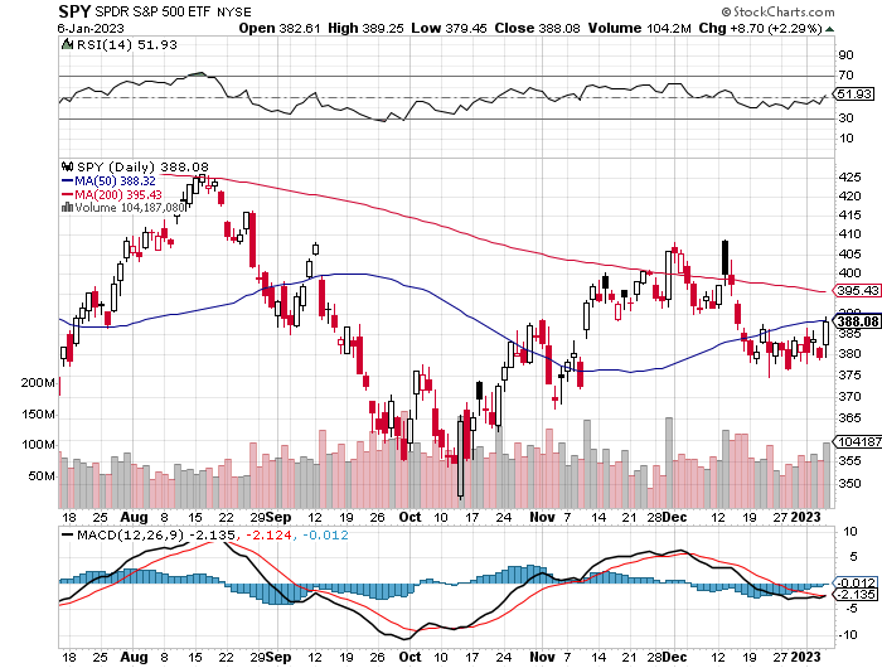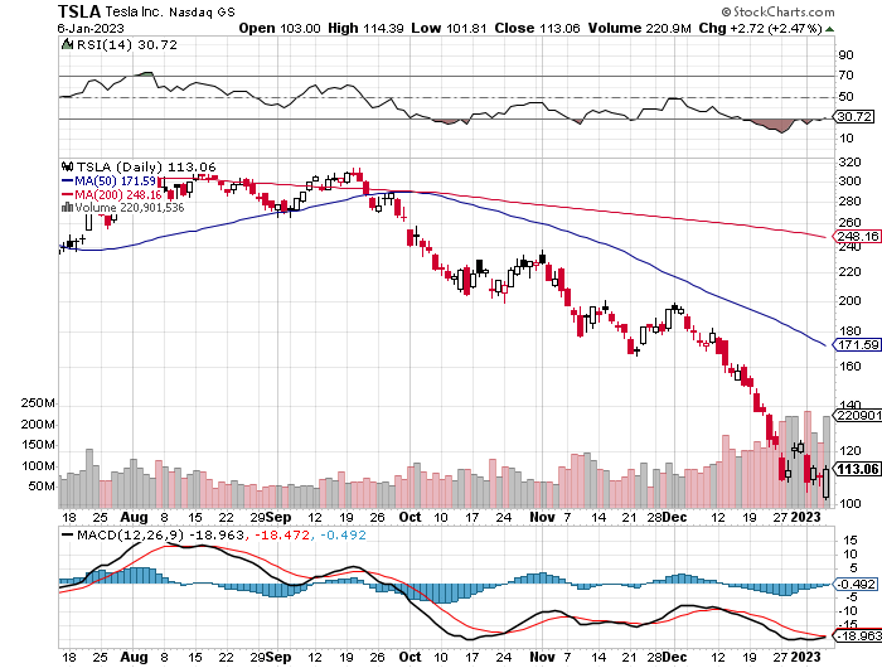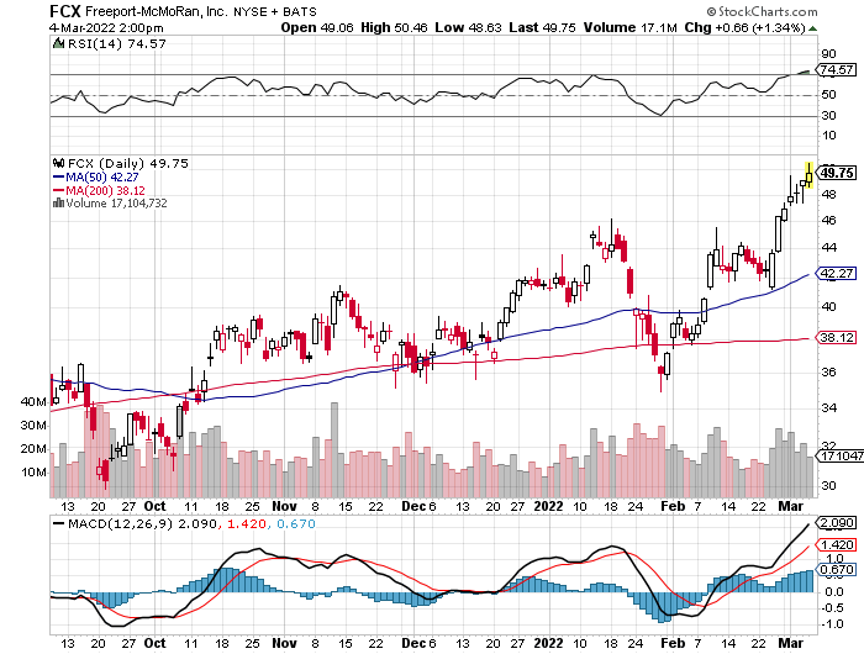The market went into the new year short. After listening to dire forecasts for 2023 and January in particular, institutional investors raised cash and hedge funds sold short. That was made clear by the explosive move up in the market on Friday.
Those blinkered by a short-term view got slaughtered. Those who pursued my own long-term view expounded in my Wednesday, January 4 letter made a killing.
The December Nonfarm Payroll Report was the trigger. The headline numbers were just warm, not hot. But the average hourly earnings dropped by half, meaning workers are getting hired at lower pay levels. If we get an even modest inflation print at 8:30 AM on Thursday, January 12, you could get another gap up move in “RISK ON” markets.
The financial markets continue “pull forward movement” as they did for much of the second half of 2022.
The post-Election rally happened in October.
The Santa Claus rally took place in November.
The New Year January selloff struck in December, closing the year near a low.
What happens next?
Another dive at the lows will attack in February.
This is typical of bear markets where liquidity is thin, trading is dominated by a handful of professionals and algorithms, and individual investors are missing in action.
What is most puzzling even to me is how the Volatility Index (VIX) is remaining artificially low at $22. Is the index storing up volatility for a future run at $30 or $40?
We shall see.
My performance in January has so far tacked on an explosive +13.39%. My 2023 year-to-date performance was the same at +13.39%, a spectacular new high. The S&P 500 (SPY) is up +2.29% so far in 2023.
It is the greatest outperformance on an index since Mad Hedge Fund Trader started 15 years ago. My trailing one-year return maintains a sky-high +98.02%.
That brings my 15-year total return to +610.58%, some 2.81 times the S&P 500 (SPX) over the same period and a new all-time high. My average annualized return has ratcheted up to +46.67%, easily the highest in the industry.
I used the new year to go maximum bullish. First, I covered my short in Apple (AAPL) for a nice profit. I took my weighting in long bonds (TLT) up to 50%, which then nicely went ballistic. I also poured on new longs in Tesla (TSLA), Berkshire Hathaway (BRKB), and the metals stocks Barrick Gold (GOLD) and Wheaton Precious Metals (WPM).
That leaves me 90% long and 10% in cash, which I am holding back to add a new short in the (QQQ) at the next market top.
I have been getting a lot of questions about the chaos in the US House of Representatives. It greatly raises the risk of a default on US government debt by the summer and certainly casts a shadow over my 50% long bond position.
It also makes a government shutdown a sure thing, which is a big market negative. However, I don’t expect it to last more than a month.
The US government is basically a big recycling machine which sucks money from the coasts and spends it inland. For example, New York and California get back 75 cents of every tax dollar they send to Washington, while Wyoming and North Dakota get $1.25. They have long distances and few people. The big winners are Alaska and Hawaii, which get back $7.00 and $8.00 because of massive infrastructure and military spending.
Once red states see cash flow from the federal government dry up, opposition to a budget deal will dry up. It always does, usually after one billing cycle.
But if prices flatline and don’t fall, I’ll still make my maximum profit. I’ll just get less sleep at night.
Nonfarm Payroll Report Comes in Warm at 223,000 for November, presenting markets with a Goldilocks scenario. The Headline Unemployment Rate fell to an eye-popping 3.5%, a post-Covid low. Average hourly earnings dropped by half to 0.3% and up 4.6% YOY. No stock market crash here. If the Fed is trying to cause mass joblessness with high interest rates to kill inflation, it’s failing miserably.
Tesla to Announce Fifth Factory in Mexico, near Monterey, the Detroit of Mexico. The move is an important step in taking Tesla to an annual production of 20 million units a year, or 20% of the global car market by 2030. Construction should cost $10 billion - $20 billion. The move is a stroke of genius and is reminiscent of the old Elon Musk. By setting up in Mexico, Tesla can gain ample cheap skilled labor from the General Motors, Ford, and Hyundai factories already there. They negotiated priority customs clearance for parts coming into Mexico and finished cars headed north by rail. It is close to Texas where Tesla is already ramping up production at an Austin plant. The most likely product will be the hot-selling Model Y.
Tesla Suspends Production at Shanghai Plant in response to a rampant Covid-19 wave far worse than disclosed. The Beijing government claims only 2.5 million cases in 2022. But a leaked top-secret report says the true figure is closer to 250 million. The final capitulation selloff in Tesla is at hand. Buy calls, call spread, shares, and two-year LEAPS.
Tesla Q4 Sales Come in Short, delivering 405,278 and 1.3 million for all of 2023. The slight miss took the shares down an astounding 14%, a huge overreaction. The stock is now selling for 22 times 2023 earnings and 11 times 2025 earnings, compared to an average of 17 times earnings for the top four tech companies. That’s an eye-popping 35% discount to big tech. It’s certainly worth taking a risk going long here for a company that is still growing earnings by 40% a year.
Japan Reverses 30-Year Easy Money Policy, allowing interest rates to float up from 0.25% to 0.50%. The Japanese yen soared 4% on the move, the world's most shorted currency, which hedge funds used to fund all positions. US bonds tanked $5 in two days, as Japan is the largest buyer of US Treasury bonds (TLT). Higher rates may bring some of that money back to Japan. It’s all an indication that the US dollar has hit a decades-long peak.
Existing Home Sales Collapse, down 7.7% in November to a seasonally adjusted 4.09 million units. They are off 35.4% YOY. The median sales price is still rising, up 3.5%, to $370,700. Supplies are still tight, so 61% of homes sold in less than a month.
Wells Fargo Gets Tagged for $3.7 Billion, in fines for its seemingly never-ending supply of past offenses. The shares dropped 10% on the news. Avoid (WFC) for now. There are better banks to buy, like (JPM), (BAC), and (C).
Shipping Costs Dive 40%, as supply chain problems end. Container prices from China cratered from $40,000 to $6,000. The market is now discounting a 2023 recession when nobody buys anything. Some retailers are dropping prices by 70%-80%, especially in clothing. The pandemic era over-ordering has come back to haunt buyers.
Case Shiller Drops to 9.24% Annual Gain in October with its National Home Price Index, the fourth consecutive monthly decline. Miami (+21.0%), Tampa (+20.5%), and Charlotte (15.0%) led the gains. The price increase rate has dropped by half in a year.
Fed Minutes Remain Restrictive at the December 12 meeting, with inflation cited as the greatest threat to the economy. Actually, I think the Fed is the threat. All governors voted to maintain a tight policy. They cautioned against an unwarranted early easing. They cited “data dependence,” meaning that when the recession hits in the coming year, they will lower rates then expect a below-trend growth for 2023. Not what a bull wanted to hear.
Natural Gas Crashes, down 10% on the first trading day of 2023 to a new one-year low. Oil also took a 3% hit. The European gas crisis is over and energy markets are discounting a Russian surrender sometime this year. Gas may also be discounting a full-blown recession and warmer weather to come. Avoid all energy plays like the plague. Gas is now cheaper than coal in a race to the bottom.
My Ten-Year View
When we come out the other side of the recession, we will be perfectly poised to launch into my new American Golden Age, or the next Roaring Twenties. The economy is decarbonizing and technology hyper-accelerating, creating enormous investment opportunities. The Dow Average will rise by 800% to 240,000 or more in the coming decade. The new America will be far more efficient and profitable than the old. Dow 240,000 here we come!
On Monday, January 9 at 8:00 AM, the Consumer Inflation Expectations are published.
On Tuesday, January 10 at 8:30 AM, the NFIB Business Optimism Index is out
On Wednesday, January 11 at 8:00 AM, a new batch of Mortgage Data is announced.
On Thursday, January 12 at 8:30 AM EST, the Weekly Jobless Claims are announced. So is the Consumer Price Index for December.
On Friday, January 13 at 8:30 AM EST, the Michigan Consumer Sentiment is disclosed. At 2:00, the Baker Hughes Oil Rig Count is out.
As for me, having visited and lived in Lake Tahoe for most of my life, I thought I’d pass on a few stories from this historic and beautiful place.
The lake didn’t get its name until 1949 when the Washoe Indian name was bastardized to come up with “Tahoe”. Before that, it was called the much less romantic Lake Bigler after the first governor of California.
A young Mark Twain walked here in 1863 from nearby Virginia City where he was writing for the Territorial Enterprise about the silver boom. He described boats as “floating in the air” as the water clarity at 100 feet made them appear to be levitating. Today, clarity is at 50 feet, but it should go back to 100 feet when cars go all-electric.
One of the great engineering feats of the 19th century was the construction of the Transcontinental Railroad. Some 10,000 Chinese workers used black powder to blast a one-mile-long tunnel through solid granite. They tried nitroglycerine for a few months but so many died in accidents they went back to powder.
The Union Pacific moved the line a mile south in the 1950s to make a shorter route. The old tunnel is still there, and you can drive through it at any time if you know the secret entrance. The roof is still covered with soot from woodfired steam engines. At midpoint, you find a shaft to surface where workers were hung from their ankles with ropes to place charges so they could work on four faces at once.
By the late 19th century, every tree around the lake had been cut down for shoring at the silver mines. Look at photos from the time and the mountains are completely barren. That is except for the southwest corner, which was privately owned by Lucky Baldwin who won the land in a card game. The 300-year-old growth pine trees are still there.
During the 20th century, the entire East shore was owned by one man, George Whittell Jr., son of one of the original silver barons. A man of eclectic tastes, he owned a Boeing 247 private aircraft, a custom mahogany boat powered by two Alison aircraft engines, and kept lions in heated cages.
Thanks to a few well-placed campaign donations, he obtained prison labor from the State of Nevada to build a palatial granite waterfront mansion called Thunderbird, which you can still visit today (click here). During Prohibition, female “guests” from California crossed the lake and entered the home through a secret tunnel.
When Whittell died in 1969, a Mad Hedge Concierge Client bought the entire East Shore from the estate on behalf of the Fred Harvey Company and then traded it for a huge chunk of land in Arizona. Today, the East Shore is a Nevada State Park, including the majestic Sand Harbor, the finest beach in the High Sierras.
When a Hollywood scriptwriter took a Tahoe vacation in the early 1960s, he so fell in love with the place that he wrote Bonanza, the top TV show of the decade (in front of Hogan’s Heroes). He created the fictional Ponderosa Ranch, which tourists from Europe come to look for in Incline Village today.
In 1943, a Pan Am pilot named Wayne Poulsen who had a love of skiing bought Squaw Valley for $35,000. This was back when it took two days to drive from San Francisco. Wayne flew the China Clippers to Asia in the famed Sikorski flying boats, the first commercial planes to cross the Pacific Ocean. He spent time between flights at a ranch house he built right in the middle of the valley.
His wife Sandy bought baskets from the Washoe Indians who still lived on the land to keep them from starving during the Great Depression. The Poulsens had eight children and today, each has a street named after them at Squaw.
Not much happened until the late forties when a New York Investor group led by Alex Cushing started building lifts. Through some miracle, and with backing from the Rockefeller family, Cushing won the competition to host the 1960 Winter Olympics, beating out the legendary Innsbruck, Austria, and St. Moritz, Switzerland.
He quickly got the State of California to build Interstate 80, which shortened the trip to Tahoe to only three hours. He also got the state to pass a liability limit for ski accidents to only $2,000, something I learned when my kids plowed into someone, and the money really poured in.
Attending the 1960 Olympics opening ceremony is still one of my fondest childhood memories, produced by Walt Disney, who owned the nearby Sugar Bowl ski resort.
While the Cushing group had bought the rights to the mountains, Poulsen owned the valley floor, and he made a fortune as a vacation home developer. The inevitable disputes arose and the two quit talking in the 1980s.
I used to run into a crusty old Cushing at High Camp now and then and I milked him for local history in exchange for stock tips and a few stiff drinks. Cushing died in 2003 at 92 (click here for the obituary)
I first came to Lake Tahoe in the 1950s with my grandfather who had two horses, a mule, and a Winchester. He was one-quarter Cherokee Indian and knew everything there was to know about the outdoors. Although I am only one-sixteenth Cherokee with some Delaware and Sioux mixed in, I got the full Indian dose. Thanks to him I can live off the land when I need to. Even today, we invite the family medicine man to important events, like births, weddings, and funerals.
We camped on the beach at Incline Beach before the town was built and the Weyerhaeuser lumber mill was still operating. We caught our limit of trout every day, ten back in those days, ate some, and put the rest on ice. It was paradise.
During the late 1990s when I built a home in Squaw Valley, I frequently flew with Glen Poulsen, who owned a vintage 1947 Cessna 150 tailwheel, looking for untouched high-country lakes to fish. He said his mother was lonely since her husband died in 1995 and asked me to have tea with her and tell her some stories.
Sandy told me that in the seventies she asked her kids to clean out the barn and they tossed hundreds of old Washoe baskets. Today Washoe baskets are very rare, highly sought after by wealthy collectors, and sell for $50,000 to $100,000 at auction. “If I had only known,” she sighed. Sandy passed away in 2006 and the remaining 30-acre ranch was sold for $15 million.
To stay in shape, I used to pack up my skis and boots and snowshoe up the 2,000 feet from the Squaw Valley parking lot to High Camp, then ski down. On the way up, I provided first aid to injured skiers and made regular calls to the ski patrol.
After doing this for many winters, I finally got busted when they realized I didn’t have a ski pass. It turns out that when you buy a lift ticket you are agreeing to a liability release which they absolutely had to have. I was banned from the mountain.
Today Squaw Valley is owned by the Colorado-based Altera Mountain Company, which along with Vail Resorts owns most of the ski resorts in North America. The concentration has been relentless. Last year Squaw Valley’s name was changed to the Palisades Resort for the sake of political correctness. Last weekend, a gondola connected it with Alpine Meadows next door, creating the largest ski area in the US.
Today, there are no Washoe Indians left on the lake. The nearest reservation is 25 miles away in the desert in Gardnerville, NV. They sold or traded away their land for pennies on the current value.
Living at Tahoe has been great, and I get up here whenever I can. I am now one of the few surviving original mountain men and volunteer for North Tahoe Search & Rescue.
On Donner Day, every October 1, I volunteer as a docent to guide visitors up the original trail over Donner Pass. Some 175 years later, the oldest trees still bear the scars of being scrapped by passing covered wagon wheels, my own ancestors among them. There is also a wealth of ancient petroglyphs, as the pass was a major meeting place between Indian tribes in ancient times.
The good news is that residents aged 70 or more get free season ski passes at Diamond Peak, where I sponsored the ski team for several years. My will specifies that my ashes be placed in the Middle of Lake Tahoe. At least, I’ll be recycled. I’ll be joining my younger brother who was an early Covid-19 victim and whose ashes we placed there in 2020.
The Ponderosa Ranch
The Poulsen Ranch
At the Reno Airport
Donner Pass Petroglyphs

An Original Mountain Man




































